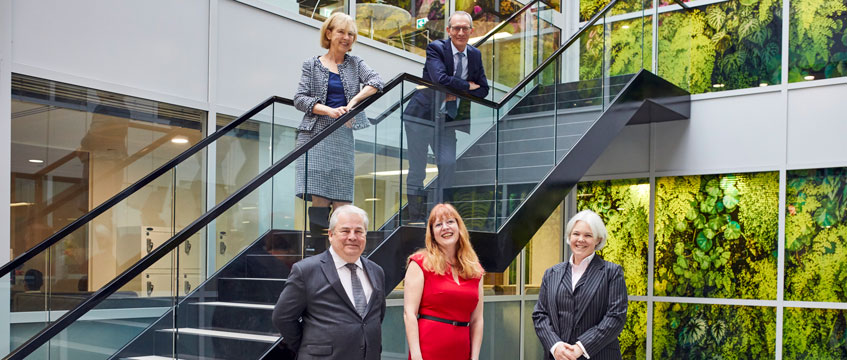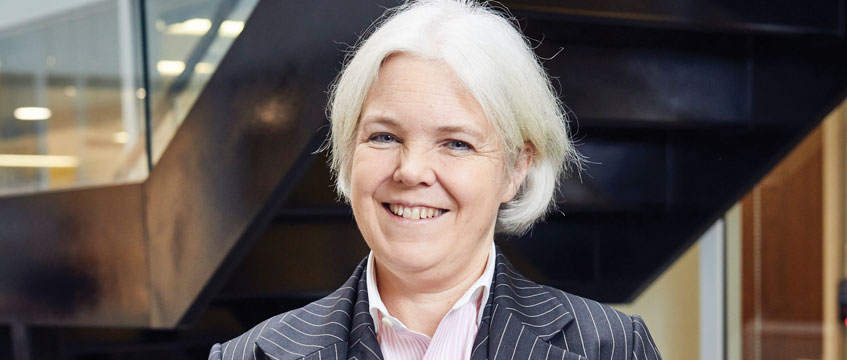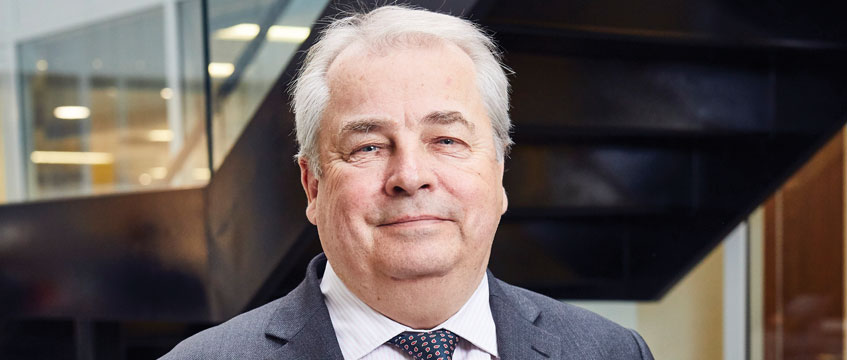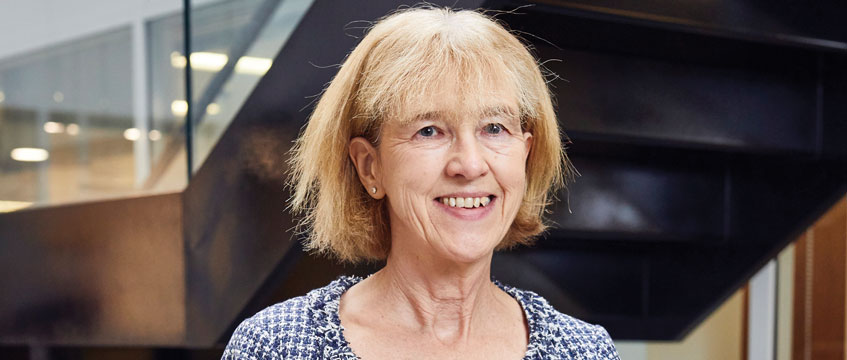The Property Mediators bubble over with enthusiasm. The group – which started in 2013 and has been in its current formation since 2018 – is going from strength to strength. Not only has it increased in number, it has pioneered processes which it believes are ahead of the curve and is on the cusp of expanding its commercial offering from resolving property disputes to facilitating property transactions.
Formed of five ex-property litigators (two barristers and three solicitors), the group comprises Jacqui Joyce, Gary Webber, Sara Benbow, Sue O’Brien and Iain Travers, all bound together by a shared passion for resolving property disputes in a less adversarial and more cost-effective way.
A collaborative approach
They perceive huge benefits to working collaboratively, principally the ability to bounce ideas, compare mediation processes, provide feedback and mentor one another. It helps to guard against the lone nature of the profession, which O’Brien pinpoints: “Mediation is necessarily quite an isolated and isolating profession. It is bound by strict confidentiality. So you’re on your own. And it would be very easy in any profession, if you’re working on your own all the time, just to fall into the same old habits and not improve it.”
To guard against any inertia, the group has implemented a formal peer review system with set documentation, which requires a member of the group to accompany another member to a mediation and take notes, then feed back after the day. If there is a particular point that comes out of it that is worth sharing, then it can be highlighted to the whole group at one of their regular meet-ups.
The Civil Mediation Council launched a consultation in November 2018 – Mentoring, Peer Review and Reflective Practice – which sought views on introducing some form of support and review into the profession. The paper makes clear that the CMC’s Registration and Standards Committee is in favour of “the increased use of mentoring and some form of reflective practice” for civil and commercial mediators. It points to the existence of supervision in family mediation in the UK and the Mediation Institute of Ireland’s requirement that all strands of mediation – including commercial mediators – must adopt it, as current examples.
For Travers, the advantages are obvious: “You see other ways of doing things. We benefit from other people’s experiences. That works both ways, both for the reviewer and for the reviewee. Both people get something out of it.”
Skills for the job
If it is their collaboration that enhances their skill sets, then it is their particular expertise in property law that benefits the client.
“We hit the ground running when it comes to figuring out what the disputes are about,” says Joyce. “We can ask the right questions when we do what we call ‘reality testing’. But also we understand the market and we understand possible solutions, which gives us, I think, an extra way of bringing something to the party.”
It is a sentiment echoed by Benbow: “A real understanding of the types of issue that we are talking about is crucial. If the sides have to spend the first hour of the day explaining what their case is all about, then the day is probably not going to succeed.”
Aside from specific property expertise, Benbow cites three other key skills that are critical to success – the first of which is impartiality. “You’ve got to be able to view a situation neutrally with an open mind, being genuinely impartial and non-judgmental about what you see in front of you. And you have to be able to maintain that even in the face of some quite often challenging behaviour from parties in the course of a day. You can’t at any stage slip into favouring one over the other because then the process would fall apart.”
The next requirement is people skills: the ability to gain trust, listen, build a rapport with both sides and ensure that each party has a chance to adequately air their views. The third is management skills. The mediators effectively have an eight-hour mediation day and probably a couple of calls with each side’s legal representatives beforehand to try and resolve an issue that may have been ongoing for many years. “To change that energy of conflict into resolution in eight hours takes a heck of a lot of managing,” says Benbow. “So the only way that’s going to happen is if the mediator brings the dynamic energy. You’re the one who has to direct this process, to make sure it keeps moving along and that the parties don’t slip back from focusing on potential solutions to arguing about why they’re right and the other side is wrong.”
Building on success
And move forward they almost certainly do. While a mediation might not always settle (though Travers, who keeps his own records, estimates that around 75% of his mediations settle either on the day or very shortly thereafter), there are other ways of judging its success. As Webber reflects, it “can be each side seeing where they are, with some sort of shift towards some sort of realisation. At each level, there’s some sort of value; something that comes out of it.”
Encouraged by the success of mediation as a means of conflict resolution, they have identified an opportunity to expand their remit to facilitating discussions in situations beyond the traditional litigation dispute. Their experience suggested that these scenarios were “more a case of two parties trying to sort out a situation which was non-litigious in nature, but having difficulty – hitting a stumbling block of some sort and needing a hand”, says Benbow.
These scenarios might appear in a range of commercial property transactions where there is a tricky discussion to be had between multiple parties with different interests. For example, a lease renewal negotiation that has got stuck; a property development where rights need to be apportioned; or a planning situation where parties have become entrenched in their positions. A mediator could then be used to break the deadlock. According to Benbow, it’s an opportunity to “take a complete step back and look at the big picture” to see if there’s something that everybody can live with. “It is difficult to do that when you’re on the inside of a discussion,” she adds.
The idea, they say, has been well tested, the feedback positive and, they believe, represents the first time that mediation has been offered this way on an individual scale.
A continued trend
Given the increased judicial emphasis on mediation, it is easy to see that broadening the offering to help prevent disputes from arising will be received positively. The judicial message on mediation and the cost consequences of not engaging with it have been clear and, as Joyce points out, the courts are now going further and “looking more at what actually happens at mediations and what comes out of it.”
The landscape in England and Wales also mirrors what is going on in the rest of the world in relation to mediation. A recent consultation on the draft Mediation (Scotland) Bill issued in May 2019 stops short of recommending compulsory mediation, but if enacted for certain civil cases would include a mandatory process requiring parties to sit down with a statutory duty mediator to explore the possibility of a mediation. And, Travers says: “We all know once you get the parties around the table face-to-face with a duty mediator, it can be quite difficult for them to hide behind the issues. A mediation is likely to take place as a result, unless there is a very good reason for it not to happen.”
Similarly, Ireland passed the Mediation Act 2017, which obliges parties to consider mediation and requires litigants to confirm to the courts they have done so (save in certain types of exempted disputes). In August 2019, The United Nations Convention on International Settlement Agreements Resulting from Mediation – also known as the Singapore Convention on Mediation – opened for signature. It seeks to facilitate international trade by promoting mediation as an alternative and effective method of resolving trade disputes. Although the EU and UK have yet to adopt it, Singapore has passed it into law – a move which Travers describes as “a very, very significant step forward for Asia Pacific and particularly for Singapore, which has always tried to set itself up as a centre for disputes and dispute resolution”.
Encouragement not compulsion
Yet despite its increased use and promotion, there seems little enthusiasm for making mediation compulsory. As the Civil Justice Council mentioned in its November 2018 final report from its ADR Working Group – ADR and Civil Justice – there is “no or very little support for anything approximating to blanket, compulsory or automatic referral to mediation”. Yet there was support “for a stronger level of encouragement and for something close to a presumption (rebuttable in, for example, genuine test cases) that ADR would need to be tried in every case”.
Benbow affirms this point: “I think most mediators would agree that, despite the superficial attraction of having however many thousand extra cases come into mediation, we really don’t want it to be made compulsory in the strict sense, because there’s nothing worse than starting the day with a group of people who are only sitting there because they’ve been forced to be there. You need people to come to mediation because they actually want to try to sort things out.”
Compulsory it may not be, but with these five individuals in charge of the process, it is easy to see why giving it a go would be a worthwhile option.
Sara Benbow: Mediating since 2003. Joined the Property Mediators in 2013
A former barrister who practises mediation full time from Hardwicke Chambers. She has experience in mediating a range of property disputes and speaks and writes widely on property, including being a contributing author to Cousins: Law of Mortgages.
Gary Webber: Mediating since 2003. Joined the Property Mediators in 2013
Webber practised as a barrister, specialising in property law for 22 years, before focusing full time on mediation. He also writes widely, is the author of two books published by Sweet & Maxwell, maintains a website – www.propertylawuk.net – and sits as a deputy district judge.
Jacqui Joyce: Mediating since 2001. Joined the Property Mediators in 2013
A former property litigation solicitor, Joyce was chair of the Property Litigation Association and was instrumental in the adoption of the Dilapidations Protocol into the CPR. She also chaired the RICS working party that produced the Guidance Note on Mediation for its members.
Iain Travers: Mediating since 1999. Joined the Property Mediators in 2018
A former property litigator who headed the real estate disputes practice at Nabarro LLP between 1987 and 2012, before moving to Ashurst to head its real estate disputes practice until 2018. In that time, he worked on a wide range of property disputes.
Sue O’Brien: Mediating since 2009. Joined the Property Mediators in 2016
O’Brien is a former property litigation solicitor who has practised in London and Paris. She has experience of mediating across a range of disputes including land and property; professional liability and insurance; probate and inheritance disputes; and commercial.













